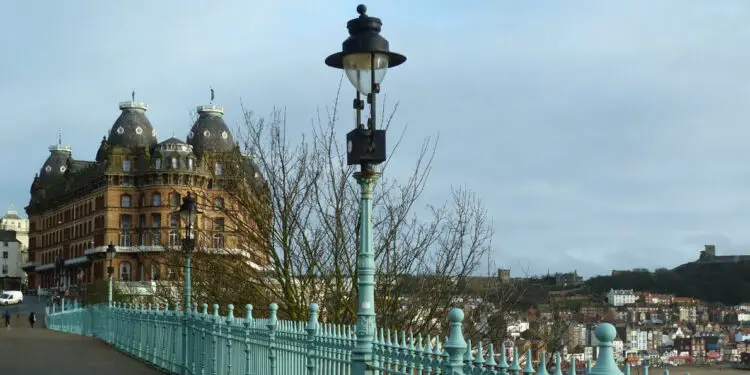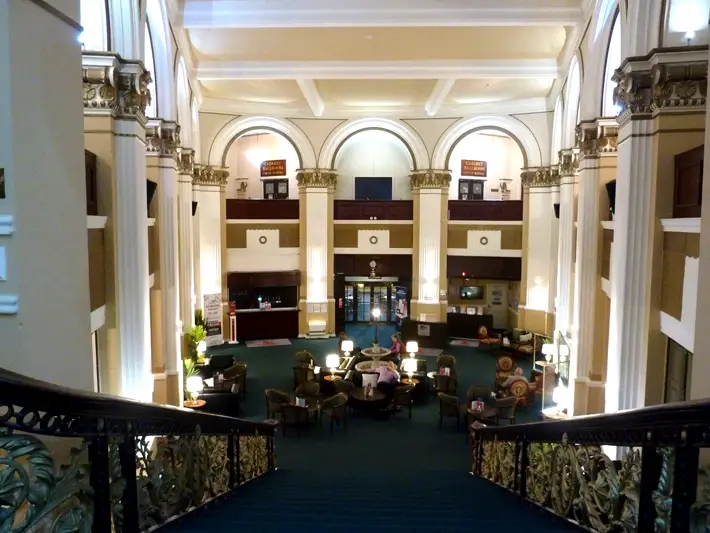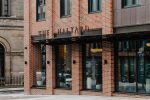A Coach Trip to Scarborough and The Grand Hotel – Review

By Clare Jenkins, March 2023
Playwright Alan Ayckbourn once said of his adopted town of Scarborough, “In the winter, everyone hangs up their welcome mats, and the town returns to the natives.”
Nowadays, some of those natives swap the cold grey skies for Benidorm’s warmth and sunshine as soon as they’ve hung up the mats in their B&Bs and guest-houses.
But there are still places to stay in wintery Scarborough. So, last month (February), my husband and I took a winter break there. It had been a couple of years since our last visit, we fancied seeing the sea, and the trip was cheap – £312 all told for four nights half-board, coach travel there and back, excursions to Goathland, Whitby, York and Beverley, hotel entertainment every night and two-for-one drinks. What not to like?
Well, within ten minutes of boarding our coach in Sheffield, we knew. Our driver – seemingly loaned out by Hi-de-Hi! – pointed out the house where the late comedian Barry Chuckle had lived, referenced the Beverley Sisters, treated us to a short history of the Bendibus and ran a football quiz which included lines like “They play like pansies”.
He told us we were all “too old” to go to the various KFCs and MacDonald’s we passed, snapped “You should look where you’re going!” when a passenger nearly fell down the coach steps, and said of another passenger, “The lights are on, but no-one’s at home.” My, how we all laughed.
“Gilded elegance”
Our accommodation for the week was The Grand Hotel. Built in 1867, it instantly became the largest hotel in Europe as well as one of the most imposing – it’s been compared to mad King Ludwig of Bavaria’s Neuschwanstein Castle. However, like the town itself, it has seen considerably better days. It still has a magnificent central “I’m ready for you now, Mr De Mille” staircase. But the gilded elegance of the huge lobby, with its throne-like chairs, padded sofas and discreet piano, is rather marred by the Coca Cola machines and snooker tables lurking nearby.
Within minutes of arriving in our shoebox-sized bedroom (one of 413 bedrooms throughout the hotel, 96 of which curiously lack windows), the towel rail had collapsed. The hot water tap dripped continuously and we had some difficulty opening the door again. That probably explained the fist-sized crack in the door panel which previous occupants had presumably used in order to escape. (To be fair, the rail and tap were repaired within hours of us reporting them to the helpful receptionists).
The anaglypta-wallpapered room was tightly packed with a 1950s-style kidney-shaped bedside table, a desk and chair, a bed with thin duvet and bouncy mattress and a flimsy-looking wardrobe. “At least you’ve got hangers – we haven’t!” we later heard another couple complain. On the plus side, there was a hairdryer, a TV with radio included, and an iron and ironing-board.
“Sweeping view”
But it was 6:30pm, coach-party-time to eat, first strapping on orange wristbands to benefit from those two-for-one drinks. The 200-seater restaurant showed signs of former glory with its white and gold décor, Regency-blue panels, floor-to-ceiling pelmetted curtains, and its sweeping view of the South Bay.
The buffet offered traditional English fare – variations each night of chicken, fish and meat, with industrial quantities of veg. For non-meat-eaters like us, there was tasty vegetable lasagne/bake/risotto over the course of the four nights. Plus a range of cakes for dessert, and entertainment in the form of restaurant manager Richard Ayres, running an admirably efficient operation in addition to being something of an expert on history, art and architecture. Of Yorkshire artist Atkinson Grimshaw’s landscapes, he said they depicted “Days that are foggy and damp and dreamy”.
After dinner, we gave bingo a miss, and instead took our wristbands into the spacious Empress Lounge, where once there would have been dance bands and swirling skirts. Now the focus was on televised football. Somehow, the twinkling slot machines in one corner and the ‘bucket-and-spade installation’ in another didn’t match the gold-and-cream, pillared and chandeliered grandeur.
“Lightning tour”
The next day’s excursion was across the misty, brackeny North Yorkshire Moors to Goathland, ‘Heartbeat Country’, where everything apart from the cafe and village shop seemed to be closed.
Thankfully, Whitby, our next stop, was fully open, so we headed straight for Whitby Museum in Pannett Park. This wonderful ‘cabinet of curiosities’ – currently celebrating its bicentenary – reflects the town’s strong maritime heritage and its ‘Jet Coast’ as well as exploring its social history and the photography of pioneering Victorian photographer Frank Meadow Sutcliffe. It also reflects the area’s significance in the history of geology and evolution, with internationally important fossils and ammonites and a huge sea dragon, or ichthyosaurus, splayed out fully along one wall.
Sarah Porteus gave us a lightning tour of some of the objects. They included Bess, a 100-year-old wooden doll used to train dogs to rescue children from the harbour; a life-size model of a crow’s nest, invented by Arctic seafarer William Scoresby; an 1830s Narwhal skeleton; a Maori war canoe; and the infamous Hand of Glory: the mummified hand of a hanged man, reputedly used by Victorian burglars to send house-occupants into a deep sleep.
There’s the tempest prognosticator (an eccentric way of predicting storms at sea) invented by the aptly-named Dr George Merryweather, Zulu snuffboxes, Bram (Dracula) Stoker’s signature, and a nightgown belonging to Queen Victoria in her later, lumpier years.

Carving of a musician on Beverley Minster
image: Stephen McClarence
“Perpetual refurbishment”
Down at the harbour and across the bridge, a 17th Century house down one of Whitby’s winding alleyways hosts the Captain Cook Memorial Museum. Cook lived here when serving as a ship-owner’s apprentice, and his subsequent life is covered in a fine collection of paintings, drawings, documents and maps detailing his various explorations, including his 1768 voyage to the South Pacific and subsequent crossing of the Antarctic Circle, celebrated in the exhibition ICE!, on until October.
Back at the Grand, hotel manager Mark Johnston gave us a tour of the hotel, with its Palm Court Ballroom – panoramic views just visible through the sea-sprayed windows -, 450-seater Cabaret Ballroom, Cricketers lounge (sea-green armchairs plus cricketing photos on the walls), wedding suite, and its seemingly perpetual refurbishment. “We’re like Marmite,” he said. “You either love or hate us.” So what does he love about it? “The character of the building and the staff, the customer service.”
The next day, another coach took us to Beverley, where we headed straight for the Minster with its vast nave and stunning 14th Century Percy tomb canopy. Other wonderful medieval carvings show a range of carved minstrels with their instruments – bagpipes, fiddles, trumpets, cymbals, tambourines, flutes and lutes. In the choirstalls, meanwhile, an elephant carries a howdah, a naked woman (temporarily removed during sensitive Victorian times) stares straight ahead, monks, saints and birds mingle with acrobats and archers, and a handful of medieval men engage in rude practices.
“Distinctive”
A short walk across town is the Treasure House museum, currently showing the delightful Fashion on a Plate exhibition of 1950s ceramics. These include Ridgway’s Homemaker plates with their ‘groovy’ black and white furniture design, Crown Devon’s Stockholm range, with reindeer leaping through forests, ceramics depicting ballet dancers, circus acrobats, young women in full skirts, and fairgrounds. Plus Terence Conran’s 1955 ‘Saladware’ plates, manufactured by Midwinter and ‘reflecting changing eating habits’ as the caption states.
As we arrived back at the coach, our driver asked us where we’d been. We told him. “Ooh, minster and art gallery,” he said. “You must be the only culture vultures on the coach.”
Unable to face any more such merriment, we opted out of the following day’s excursion to York in order to explore Scarborough. And, because we fancied another surfeit of crocs and rocks, shells and minerals – not to mention another sea dragon – we began with the distinctive Rotunda Museum of Geology.
Founded in the 1820s by William ‘Strata’ Smith, the ‘Father of English Geology’ and fellow members of the Scarborough Philosophical Society, the Rotunda offers a geological timeline of Britain for those who don’t know their Paoleozoic from their Cenozoic. There’s a collection of beautiful ammonite shells swirling away into infinity, the footprint of a dinosaur, the skeleton of a plesiosaur (a Loch Ness Monster-type marine reptile) found near Filey 20-odd years ago, and a stuffed great bustard (shot with its mate in Foxholes in 1835 – “the great bustard is now extinct”, states the caption, laconically).
“Jaunty”
A short walk away is Woodend, former holiday home of the Sitwell family and now a gallery and artists’ studios with a colourful, airy café. Next door is Scarborough art gallery itself, celebrating the town’s seaside story and currently showing Squaring the Circles, an exhibition exploring the relationship between art and photography.
We popped into the Market Hall, with its fruit and veg, fresh crab and lobster stalls, its bakery and its Market Tavern serving Yorkshire pudding breakfasts. In the eerily quiet basement, you can buy fairy figures from The Ivy Cavern, fruit-design jewellery from Luckenbooth’s, a copy of The Upanishads from the incense-swirling Buddha Shack, or indulge in a tarot reading, a tattoo or a body piercing.
Being more conservative in our tastes, we gave those a miss and headed back along downtrodden Westborough, seagulls laughing raucously overhead, to the harbour. No trip to Scarborough is complete without a visit to the seafront Harbour Bar, with its jaunty yellow and red décor, its waitresses in lemon and white uniforms, its vintage signs for knickerbocker glories, milkshakes and soda floats, and its delicious toasted waffles piled high with ice-cream, fresh fruit, bubble-gum sauce and whipped cream. If ever there was a café designed to cheer people up, whatever the weather, this is it.
PS: For the record, we came home by train.
The Grand Hotel has budget rooms starting at £30 without breakfast, £45 with. Standard doubles start at £60, rising to £150, with suites up to £210: britanniahotels.com
Whitby Museum: whitbymuseum.org.uk
Captain Cook Memorial Museum: cookmuseumwhitby.co.uk
The Fashion on a Plate exhibition is on at Beverley Treasure House until 6th May: eastridingmuseums.co.uk
Squaring the Circles is on at Scarborough Art Gallery until 1st May: scarboroughmuseumsandgalleries.org.uk
Top image: Stephen McClarence














